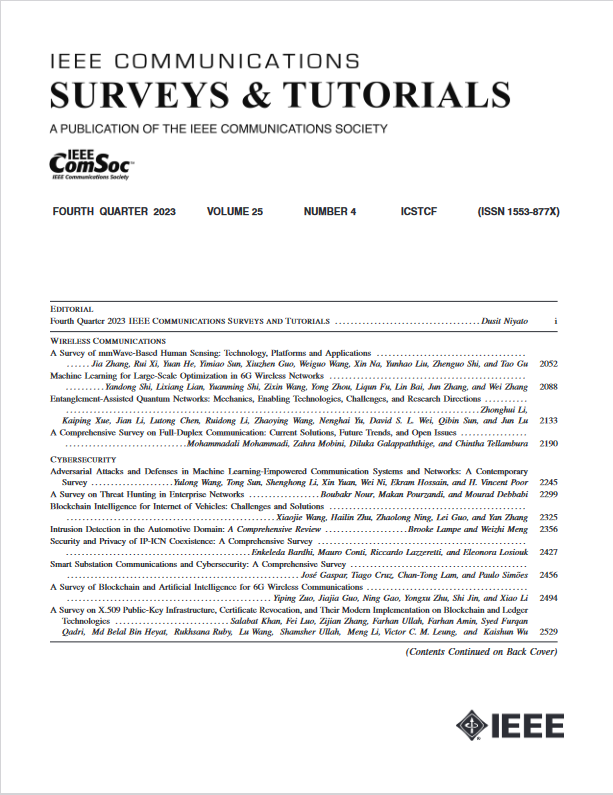后量子区块链与量子区块链的调查与比较
IF 34.4
1区 计算机科学
Q1 COMPUTER SCIENCE, INFORMATION SYSTEMS
引用次数: 0
摘要
区块链因其促进去中心化信任和通信的能力而受到学术界和工业界的广泛关注。然而,量子计算的快速发展对现有区块链技术的安全性构成了重大威胁。值得注意的是,肖尔算法和格罗弗算法的出现引发了人们对区块链底层加密系统受损的担忧。因此,必须开发出能够加强区块链技术抵御量子攻击的方法。为了应对这一挑战,人们提出了两种不同的方法。第一种方法涉及后量子区块链,旨在利用经典加密算法抵御量子攻击。第二种方法是探索量子区块链,利用量子计算机和网络的力量重建区块链的基础。本文旨在对后量子区块链和量子区块链进行全面概述和比较,同时探讨这些领域的未决问题和依然存在的挑战。本文深入介绍了后量子区块链和量子区块链,研究了区块链结构、安全性、隐私和其他关键因素的差异,最后讨论了当前的研究趋势。本文章由计算机程序翻译,如有差异,请以英文原文为准。
A Survey and Comparison of Post-Quantum and Quantum Blockchains
Blockchains have gained substantial attention from academia and industry for their ability to facilitate decentralized trust and communications. However, the rapid progress of quantum computing poses a significant threat to the security of existing blockchain technologies. Notably, the emergence of Shor’s and Grover’s algorithms raises concerns regarding the compromise of the cryptographic systems underlying blockchains. Consequently, it is essential to develop methods that reinforce blockchain technology against quantum attacks. In response to this challenge, two distinct approaches have been proposed. The first approach involves post-quantum blockchains, which aim to utilize classical cryptographic algorithms resilient to quantum attacks. The second approach explores quantum blockchains, which leverage the power of quantum computers and networks to rebuild the foundations of blockchains. This paper aims to provide a comprehensive overview and comparison of post-quantum and quantum blockchains while exploring open questions and remaining challenges in these domains. It offers an in-depth introduction, examines differences in blockchain structure, security, privacy, and other key factors, and concludes by discussing current research trends.
求助全文
通过发布文献求助,成功后即可免费获取论文全文。
去求助
来源期刊

IEEE Communications Surveys and Tutorials
COMPUTER SCIENCE, INFORMATION SYSTEMS-TELECOMMUNICATIONS
CiteScore
80.20
自引率
2.50%
发文量
84
审稿时长
6 months
期刊介绍:
IEEE Communications Surveys & Tutorials is an online journal published by the IEEE Communications Society for tutorials and surveys covering all aspects of the communications field. Telecommunications technology is progressing at a rapid pace, and the IEEE Communications Society is committed to providing researchers and other professionals the information and tools to stay abreast. IEEE Communications Surveys and Tutorials focuses on integrating and adding understanding to the existing literature on communications, putting results in context. Whether searching for in-depth information about a familiar area or an introduction into a new area, IEEE Communications Surveys & Tutorials aims to be the premier source of peer-reviewed, comprehensive tutorials and surveys, and pointers to further sources. IEEE Communications Surveys & Tutorials publishes only articles exclusively written for IEEE Communications Surveys & Tutorials and go through a rigorous review process before their publication in the quarterly issues.
A tutorial article in the IEEE Communications Surveys & Tutorials should be designed to help the reader to become familiar with and learn something specific about a chosen topic. In contrast, the term survey, as applied here, is defined to mean a survey of the literature. A survey article in IEEE Communications Surveys & Tutorials should provide a comprehensive review of developments in a selected area, covering its development from its inception to its current state and beyond, and illustrating its development through liberal citations from the literature. Both tutorials and surveys should be tutorial in nature and should be written in a style comprehensible to readers outside the specialty of the article.
 求助内容:
求助内容: 应助结果提醒方式:
应助结果提醒方式:


